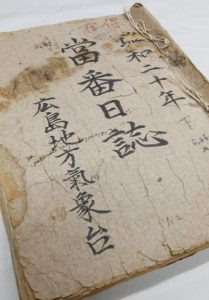@71 days until Hiroshima Summit: Ebayama Museum of Meteorology
Mar. 9, 2023
by Kyoko Shinmoto, Staff Writer
Ebayama Museum of Meteorology located in Naka Ward, Hiroshima City used to be the local meteorological observatory in Hiroshima when it was exposed to the atomic bombing. As the Japanese Army’s anti-aircraft artillery was stationed in the observatory building, it was camouflaged with black paint so it wouldn’t be clearly visible to the enemy’s aircraft.
The observatory was located about 3.7 kilometers from the hypocenter. The entire staff of the observatory was either severely or lightly injured on the way to work. According to the observatory’s duty diary kept by the museum dated August 6, 1945, “Fire and lightening often happened, and there was much rainfall in the Yokogawa area.” Though they continued to observe the weather by using equipment that hadn’t been damaged, weather forecast information was considered a military secret during the war period.
When the Makurazaki typhoon struck Hiroshima about a month after the atomic bombing, enormous damage was caused to the citizens because the weather information hadn’t been communicated due to the delayed recovery of telecommunication equipment. How the observatory staff suffered A-bombing damage but continued to observe the weather at that time is described in the book “Kuhaku no Tenki Zu (A Blank in the Weather Map)” by Kunio Yanagida.
(Originally published on March 9, 2023)
Ebayama Museum of Meteorology located in Naka Ward, Hiroshima City used to be the local meteorological observatory in Hiroshima when it was exposed to the atomic bombing. As the Japanese Army’s anti-aircraft artillery was stationed in the observatory building, it was camouflaged with black paint so it wouldn’t be clearly visible to the enemy’s aircraft.
The observatory was located about 3.7 kilometers from the hypocenter. The entire staff of the observatory was either severely or lightly injured on the way to work. According to the observatory’s duty diary kept by the museum dated August 6, 1945, “Fire and lightening often happened, and there was much rainfall in the Yokogawa area.” Though they continued to observe the weather by using equipment that hadn’t been damaged, weather forecast information was considered a military secret during the war period.
When the Makurazaki typhoon struck Hiroshima about a month after the atomic bombing, enormous damage was caused to the citizens because the weather information hadn’t been communicated due to the delayed recovery of telecommunication equipment. How the observatory staff suffered A-bombing damage but continued to observe the weather at that time is described in the book “Kuhaku no Tenki Zu (A Blank in the Weather Map)” by Kunio Yanagida.
(Originally published on March 9, 2023)








